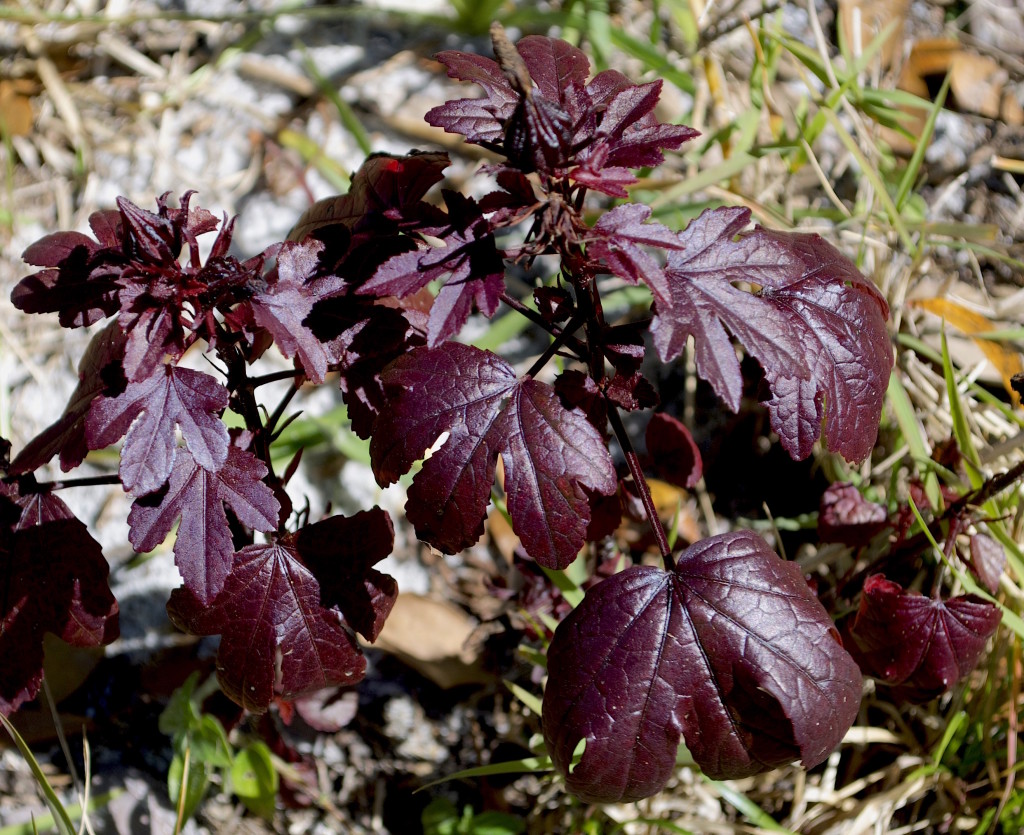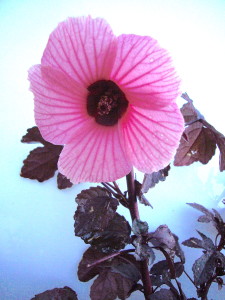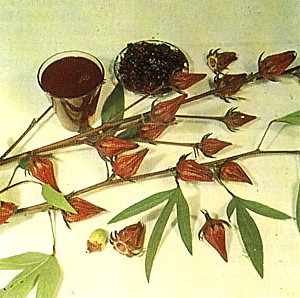I can’t do a stir-fry without visiting a tree. Actually, the False Roselle is a shrub not a tree but the point is made. Its leaves have just the right color, taste and texture for stir-fries and salads.
There’s hardly a hibiscus that’s isn’t edible in some way. Several are better than others. The False Roselle, or Hibiscus acetosella (hye-BISS-kus uh-set-o-SEL-luh) is one of the best. Its dark red leaves are tart, sorrelesque. They harvest easily, chop up easily, don’t loose bulk, color or flavor when cooking.
The first thought most plant people have when they see a False Roselle is that it looks like a red maple. On closer inspection the leaves are a different shape, and the False Roselle is a darker red, but the resemblance is there, at least to northerners. Its pink flowers are edible as well, but they are more eye candy than a palate pleaser, being nearly tasteless. The flowers usually go in salads.
One cannot mention the False Roselle without introducing the real Roselle, left. Hibiscus sabdariffa (hye-BISS-kus sab-duh-RIF-fuh) is also known as the “Florida Cranberry” the “Cranberry Hibiscus” and the Jamaican Sorrel. A tart juice can be made from its fat calyxes and it’s something of a tradition in the West Indies. Many posters on the Internet get these two hibiscus mixed up, but there is no need for it. The False Roselle ( H. acetosella) has maple-esque red leaves — older with an undertone of green — whereas the Cranberry Hibiscus (H. sabdariffa) has lance-shaped, green leaves. They look quite different.
The shrubs can take a light freeze and will come back from roots in the spring. In cold climates they will have to be a potted plant. In my yard they tend to died after five or six years but are always reseeding and sprouting so it’s not much of an issue. Hibiscus means hibiscus or slimy or sticky, and acetosella means “a little sour.” Sabdariffa is a variation of the West Indian name.
Green Deane’s “Itemized” Plant Profile: False Roselle
IDENTIFICATION: Upright and shrubby, leaves ovate to lobed, red to deep burgundy, to dark reddish green. Flowers funnel shaped, usually pink but can be yellow or red. Some cultivars don’t flower. Mature plants can split and fall over.
TIME OF YEAR: Year round in warm climates
ENVIROMENT: Plenty of sun, water, good soil and heat. They don’t like it dry or wet.
METHOD OF PREPARATION: Leaves raw or cooked, blossom raw or cooked though they tend to disappear when cooked.





Great article on the False Roselle.
I was so happy to find your post on false roselle. I moved to Okinawa several weeks ago–and as a mostly raw vegan–I have been very disappointed in the green leafy vegetables available. Due to the heat and high humidity, the intensity of the sun, the alkaline soil, and typhoons, very little grows here other than sugarcane. I have been eating a lot of purslane, and tonight, I tried false roselle in my salad for the first time. Do you happen to know the nutritional value?
I was just given one of these. Pruning: do I pinch back to make shrubby or let it grow into a standard?
TX
They can get very leggy. I think they leaf out more. look better, and are more managable when trimmed back.
Check on any encyclopedia. I think you’re mistaken, this red leaf hibiscus plant is the only calledcranberry hibiscus not the Roselle one.
According to the taste, this one has a much tart like flavor, even the leaves are much “tart” taste.
I have both and can easily differentiate.
This is the one which is called Cranberry hibiscus. If you have this plant like me, you’re very lucky. I have both Roselle and False Roselle. This False Roselle which is actually called Cranberry hibiscus.
You need to discover your beautiful plant better!
Do you know this one also has a extremely delicious tarty flavor? Just like the Roselle one, this one has sepals too
Eat the sepals! These are so good. They are finger like leaves that stick out of the calyx (the part that holds the bloom and seed pod). These are the part of the Cranberry Hibiscus that holds the most flavor. They only form when the flowers are in bloom.
New to Florida and its flora!
Do False Roselle’s have 2 different leaf shapes? I have 2 going on their second year that never grew the maple-like leaves but stayed with simple, ovate, obtuse tip, rounded base, crenate margin, deep red-burgundy color, but clearly had the beautiful pink hibiscus flowers…the interesting thing is the seedlings under the shrub have the beginnings of a palmate leave structure, and other seedlings by my compost area are starting out with ovate leaves?
They can vary a lot, from maple-ish to deeply lobed.
When I grew them in Central Florida, The variety that I had DID have more ovate leaves. I love the Maple shaped leaves much more!
I tried this for the first time tonight after finally cutting it back, really interesting! I just wasn’t sure what parts to eat…like which leaves, how big, etc., so just basically stripped all the leaves from it’s stem wherever it gave, and snapped off the growing tips. There was few toughish stems, but not too shabby! I think I am actually going to try whizzing it in the blender with water and make a drink out of it next time, nice and tart without being sour.
Do you know what parts of the Rose of Sharon are edible?
Blossoms. It is a hibiscus. I mention it in my hibiscus article.
Have you/can you make tea out of the false roselle calyx as well? Or only the plump, roselle calyx? Thanks!
You can make a tea out or either.
Hello, I know this isn’t your area of expertise, but figured I would check with you. Do you happen to know if False Roselle and Roselle are planted near one another, will they cross-pollinate and affect the quality of future seeds? Thanks again!
I would like to flavor kombucha with the false roselle calyxes. I always use raw ingredients to flavor kombucha, so I’m wondering if this will be possible using false roselle calyxes, and if you think I will have to remove the seeds within the calyxes first
Keeping the seeds in should not be a problem.
I have lots of cranberry hibiscus I believe that’s what I have I wish I could send a picture
What a wonderful article! Now I know that living in Central Florida I grow the Cranberry (false)
Hibiscus.
Aside from the edible qualities, this plant is incredibly invasive-watch it like a hawk! It crowds out everything around it.
Mine is now blooming and my butterflies like it.
The base of the plant can grow to look like the trunk of a tree, about 16-18″ around.
We had to dig up one that took root in a plant border around out swimming pool- it was starting to lift the concrete decking with its roots!
GG
Thank you for that info. I recently had a limb break off my potted fake Roselle so I stuck it directly into the ground at the edge of my pool. I will certainly move it now that I’ve read your comment. The fake Roselle comes back every year from the root system. It is a gorgeous red color, especially when the sun is behind it. We also grow Regular Roselle which I have to replace every year. Roselle jam made from the beautiful plump calyxes is amazing! Cranberry like flavor jam sweetened to taste. I’ve never tried to eat anything from the fake Roselle. I didn’t think it was edible. I have noticed the fake Roselle calyx has a prickly feel to it so I would imagine harvesting might be painful with out protective measures.
Where can I buy or get a cutting of false roselle? Living in Tampa Bay area. Thanks.
Don’t. I got one small cutting and it’s completely taken over my yard and can’t get rid of them. They grow long and leggy. Even with trimming I can’t keep up. They spread like wild fire. Everywhere I don’t want them. In my lawn, jumped to all my other gardening areas and took them over. I can’t kill them. More babies keep sprouting. I’m in hell. My beautiful garden is gone. They look great for a short time and then when they die back your stuck with giant dead branches. Even with ripping them out and burning them, they keep coming back every year. Worst plant I have.
Here in Central Florida they die out regularly in the mild winters. I have to take cuttings every fall.
In Central Florida, we never found that to be the case about invasive. My experience has been like Green Deane’s. However, that being said, there is a thing called Dead heading, in which we snap off the seed cases or even before that, the faded flower, to prevent re-seeding. I am literally in love with Hibiscus acetosella and am growing it as an annual (in zone 8A) for tea making with the leaves. (Even the dried seeds can be used; ground as a flour and added to a smoothie or any dish that would benefit from a lemony flavor) I have recently made a beautiful and delicious tea/juice from the purple leaves! Sweetened with Stevia, even the most picky anti strange food eaters love this!
I live in Michigan we been growing hibiscus for a few years.. Not sure of the names but hardy they come back every year.. We started with the large red I call them dinner plates 10 to 12 inches across.. The we got a smaller white one about 5 to 6 in.
Then a couple year a ago I found a mix color kind of pin and red mix..
They are all hardy for here in zone 4..
So can any on my hibiscus be used for tea? And edible??
As Deane says in his article on Hibiscus, they are mostly all edible, though not as tasty as Roselle and false
Roselle.